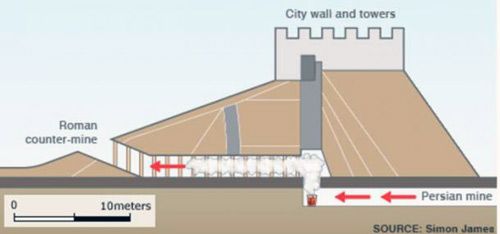Skeleton of a Persian warrior from the 3rd century CE. The soldier is still wearing his extended chain mail. The man died in the tunnel that the Sassan army wanted to get under the tower to the besieged city of Dura Europos (Syria) in 256 CE.
Persian was not alone in the tunnel. Apart from his remains, the bones of 20 Romans were found; they dug a tunnel towards the Persians.
Scientists suspect that the soldier may have suffocated from toxic fumes. They also note that the armour is clearly widened, suggesting that the suffocating man wanted to get rid of his chain mail. Another concept is that his companion just wanted to pull him to the surface and pulled him by the armour.
Simon James, an archaeologist at the University of Leicester, says that in the tunnel, the Persians set fire to the bitumen along with sulfur crystals, and the vapours of this poisonous mixture leaked into the Roman side. Interestingly, the scheme of the Persian tunnel and the location of chemical weapons indicates that the shape of the dug passage was not accidental. He was to favour underground killing.
As a result of the poisonous smoke, the Romans lost consciousness in a few seconds, and after a few minutes, they were dead. A thorough analysis of the distribution of bodies located near the entrance to the narrow excavation indicates that the soldiers were attacked at the mouth of the Persian tunnel, and from the pile of their bodies and shields the Persians built an obstacle protecting them from the Roman counterattack.








